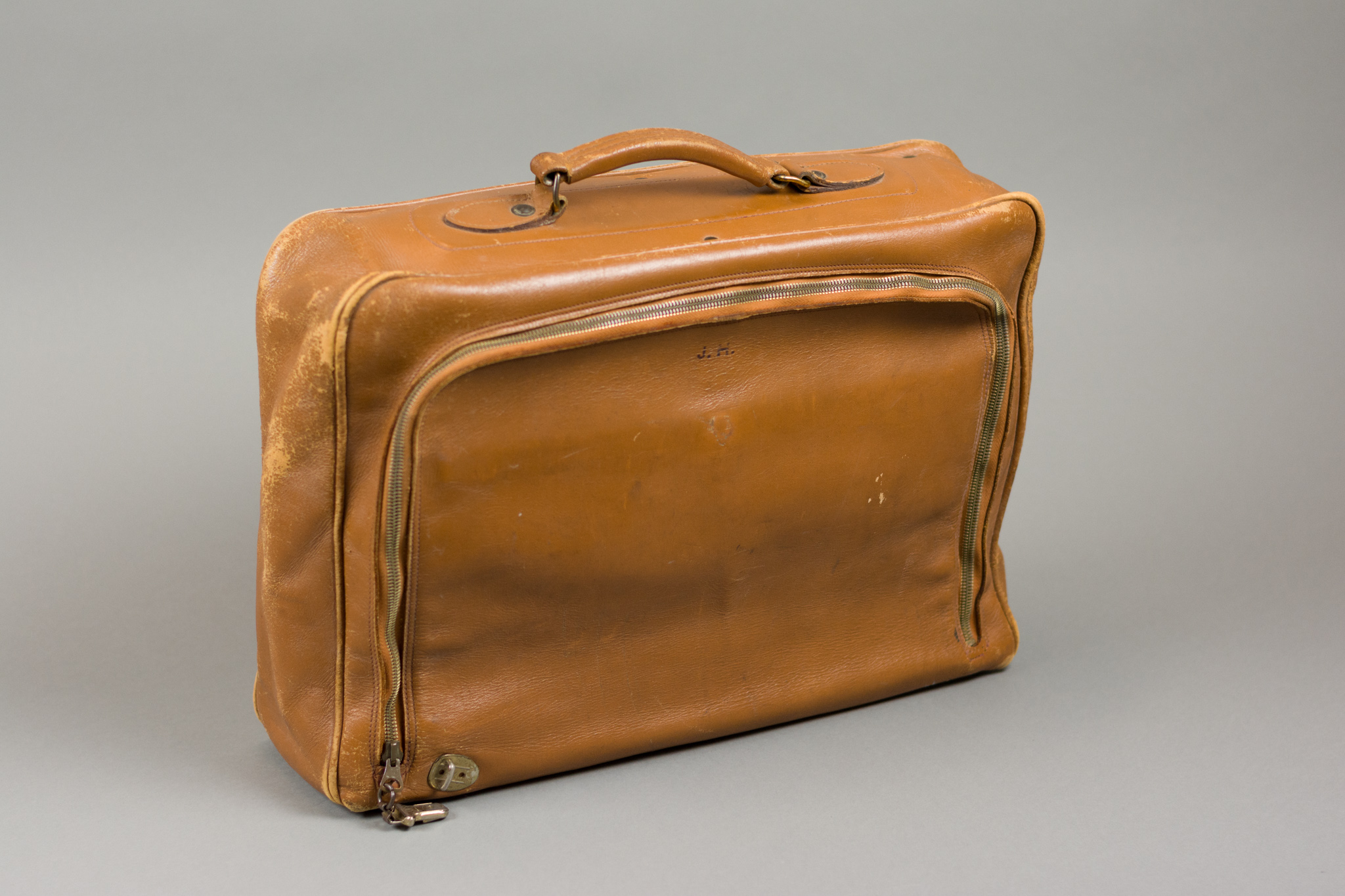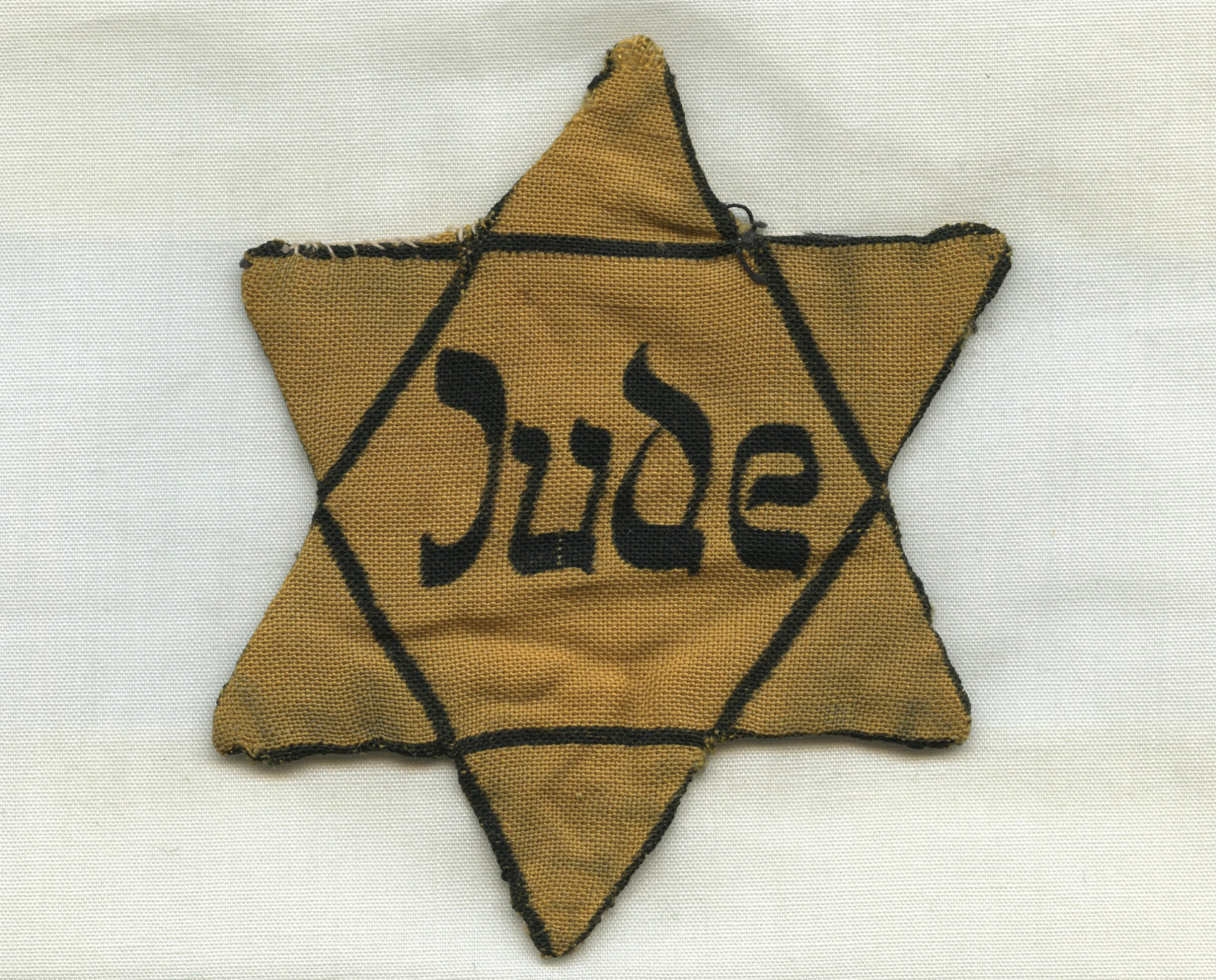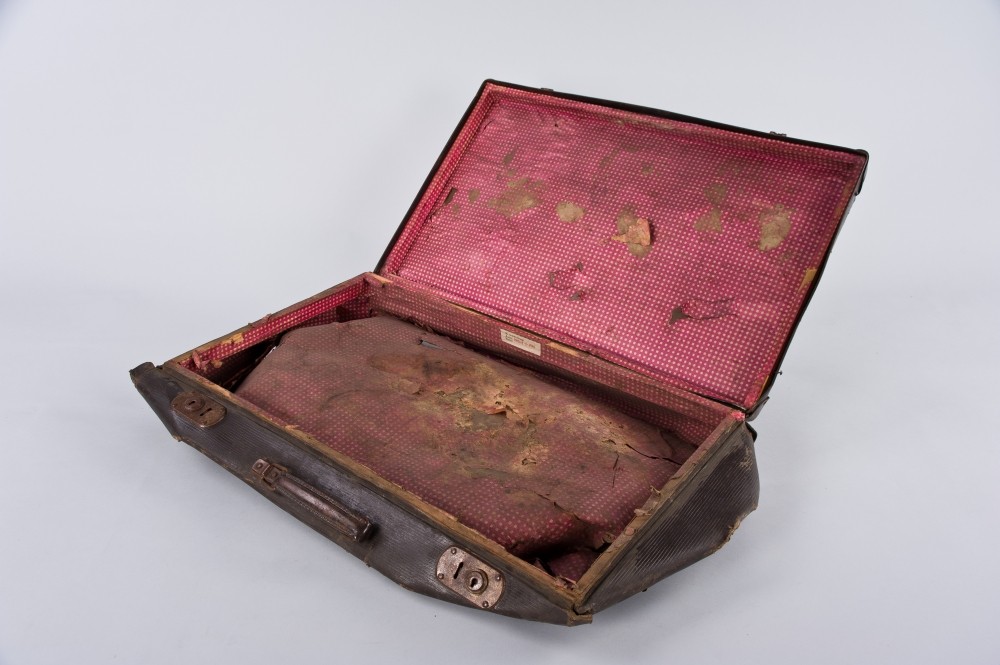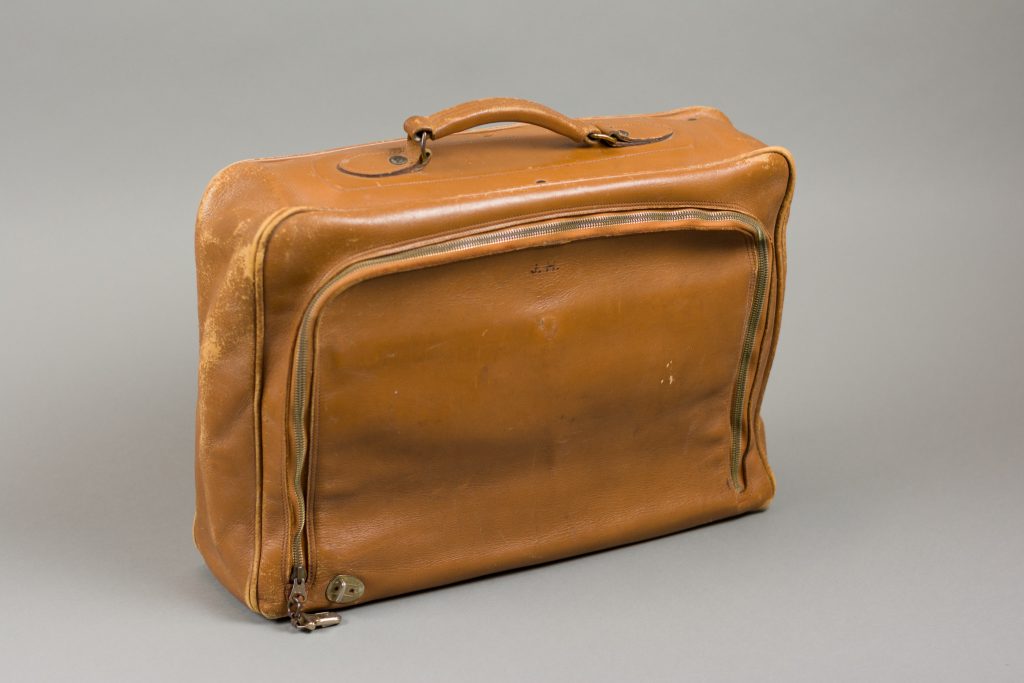By Easton Lacey
| Name of the Artefact | Suitcase | Star of David Badge belonging to Toni Neumann |
| Creator | Unknown | Unknown |
| Date | Before 1937 | 1940 – 1945 |
| Type | Cowhide Leather | Embroidered Cloth |
| Image |  |  |
| URL | https://collections.vhec.org/Detail/objects/1738 | https://collections.vhec.org/Detail/objects/2473 |
Overview
The suitcase was a daily life and household item used by many for travel purposes. This specific suitcase was likely made before 1937 with brown cowhide leather. It is unknown who made it, but the initials on the suitcase, J.H., let us know that this was John Herbert’s suitcase. Suitcases were common items among Holocaust victims as they were told to pack their belongings before deportations.
The Star of David badge was a patch for identification purposes that Jewish people were forced to wear during the Nazi period. The yellow patch was 10 Pfennig (Kluger 58) and was a piece of cloth that Jewish people had to sew onto articles of clothing that they wore in public. The Star of David badge was in use between 1940-1945 in order to mark people from the Jewish community as outsiders.
Meaning
Both the suitcase and Star of David badge played an important role in regard to the events that led up to the Holocaust. In almost every text that our class has read, the author describes the occurrence of packing before leaving home or the moment of having their belongings taken from them. In most instances, people were limited to how much they could bring with them when they were going to be deported. Hilde Sherman notes that during the time leading up to her deportation, or the “resettlement” as far as they knew, everyone tried to put all of their best belongings into one suitcase (“From the Testimony of Hilde Sherman” 1). Therefore, people packed some of their most prized possessions or valuables. Before the deportations, however, people were stripped of all belongings, and in most cases, as Sherman says, “[w]e never saw our suitcases again” (2). Of course, never seeing the suitcases again meant a loss of all belongings packed for the so-called resettlement.
As for the Star of David badge, it had to be worn from the age of six. This mandate was the beginning of the legal and systematic exclusion of Jewish people from society during the Nazi period. This artefact represents the debarment that came along with having to wear it. The badge did not only single out Jewish members of society visually, but it also meant they faced different societal rules from everyone else. Primo Levi explains the many limitations that came with this yellow star. To name a few, Levi states that Jewish people could only sit in the places specifically marked for them, all assets belonging to Jewish people were enumerated, and those wearing the star were no longer called by their birth names (Levi 56). Instead, they were only recognized by the use of the name Israel for men, and Sara for women (56). Thus, both the suitcase and the badge played a significant role in the day-to-day lives of Jewish people living under Nazi rule.
Symbolism
Origins
The mention of a suitcase is a commonality across many testimonies. This is because deportations required packing as many belongings as possible into one suitcase. The suitcase, similar to the Star of David badge, represents a power that the Nazis held over the Jewish people. The Jewish people being deported were limited to a certain amount of luggage that, in the end, was only going to be stolen from them. The suitcase symbolizes one of the first of many things to be taken from people who were victims of the Holocaust. The absence or removal of the suitcase also connects with the arrivals at camps and the deaths of Holocaust victims.
During the arrival period at camps, prisoners were stripped and ultimately dehumanized from the moment they got there. Käthe Anders was stripped, abused, handed a pinstriped outfit and sent off to the camp. In this experience, she says, “I cried only for the first few days…After that I did not cry for two years.”[1] The removal of the suitcase took away any sense of identity and forced these victims to try and adapt to a completely new and miserable environment. All prisoners were treated in the same degrading way and everyone wore the same things. Not to mention, most of the time what they wore was not suitable for the conditions they faced. As Anders writes, “[w]e didn’t have any gloves, only a headscarf, a little dress, and a jacket with sleeves that just came down to our elbows. From snowstorms home into the cold, into the cold shower.”[2] This unsuitable clothing for the weather conditions led many whose bodies could not tolerate it to their deaths.
The yellow Star of David badge, placed on the chest, was used as a way to recognize a group of people according to their ethnicity and religion. In the time the Star of David badge was created, it represented the power that the Nazis had over the Jewish community. It was a way of humiliating and segregating the Jewish people, and for some, this segregation started at a very young age. The badge made it easy for Jewish people to be seen and monitored—that is, if they did wear it, which not everyone did at all times. Ruth Kluger states in her novel that “on occasion [she] would simply go to a film without wearing the star” (61). Not wearing the star was a form of resistance, but Kluger did this to go see Nazi propaganda films. She classified this as defiance of the laws of the state, but there is a sense of irony because she was defying the laws while learning about the Nazis’ set of beliefs. Although some were able to resist wearing the star, it was still difficult to escape the dominant ideology of Nazi society.
[1] Translation of Käthe Anders, “Nie gelebt,” by Uma Kumar and William Orr, University of British Columbia, 2019.
[2] Translation of Käthe Anders, “Nie gelebt,” by Uma Kumar and William Orr, University of British Columbia, 2019.
Aftermath
Despite all of the time that has passed since the Holocaust, the meaning of these artefacts has not changed. Suitcases are still in use today for travel, but these specific suitcases that are now artefacts of the Holocaust are specially preserved.

Now, there are many suitcases on display in museums such as at the Auschwitz-Birkenau Memorial and Museum, pictured above. Of course, these suitcases are not to travel with and the meaning remains the same, as they still represent the loss of heirlooms and material possessions that many Jewish people faced once they arrived in concentration camps.
The meaning behind the yellow Star of David badge remains the same as it did during the period of the Holocaust. However, there is a difference in the symbol of the Star of David itself. After the war, Jewish people “turned this socially constructed symbol of humiliation and death into a badge of honor and community” (Greene 93). Rather than having the Star of David be a symbol of resentment, the Jewish community has returned this symbol to a place of pride. These artefacts are from an astonishing point of history that we are now able to look back on, and their preservation allows us to appreciate the information they have provided the generations before us and the information they will provide the generations to come.
Works Cited
Anders, Käthe. “Nie gelebt.” Ich geb Dir einen Mantel, daß Du ihn noch in Freiheit tragen kannst, edited by Karin Berger, Promedia, 1987, pp. 97-106.
“Auschwitz-Birkenau Historical Collection.” Auschwitz-Birkenau Memorial and Museum, 2020, auschwitz.org/en/museum/historical-collection/.
Eichengreen, Lucille, and Harriet Hyman Chamberlain. From Ashes to Life: My Memories of the Holocaust. Mercury House, 1994.
“From the Testimony of Hilde Sherman about the Deportation to Riga and the Arrival to the Ghetto.” Yad Vashem Archives, The International School for Holocaust Studies, https://www.yadvashem.org/odot_pdf/Microsoft%20Word%20-%203287.pdf. Accessed 07 May 2020.
Greene, Dana M. Judaism, Jewishness, and the Universal Symbols of Identity: Re-Sacralizing the Star of David and the Color Yellow. Penn State University Press, 2011.
Heppner, Ernest G. Shanghai Refuge: A Memoir of the World War II Jewish Ghetto. University of Nebraska Press, 1993.
Kluger, Ruth. Still Alive: A Holocaust Girlhood Remembered. The Feminist Press at CUNY, 2003. ProQuest Ebook Central, https://ebookcentral.proquest.com/lib/ubc/detail.action?docID=729241.
Levi, Primo. The Black Hole of Auschwitz. Polity Press, 2005.
Star of David Badge Belonging to Toni Neumann, 1940-1945. Vancouver Holocaust Education Centre, collections.vhec.org/Detail/objects/2473.
Suitcase. Vancouver Holocaust Education Centre, collections.vhec.org/Detail/objects/1738.



Comments by Amanda Grey